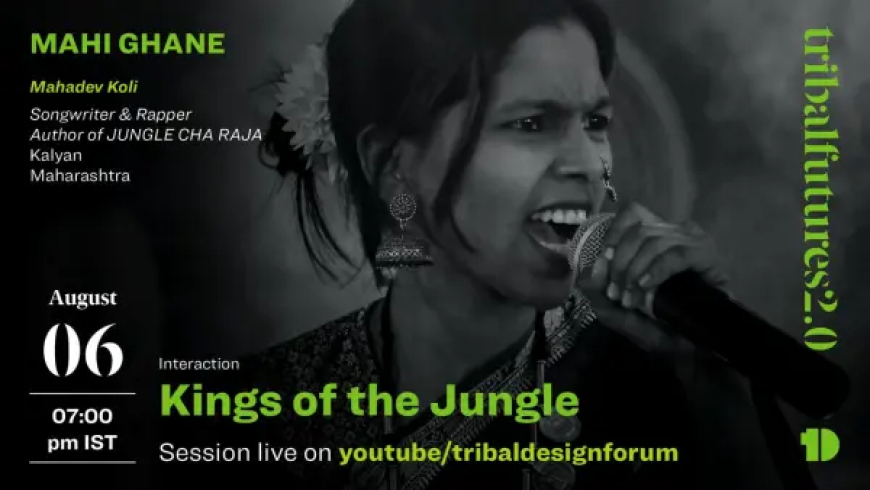Day 6 of Tribal Futures Fest 2.0: “I blend crafts with cause” — Mahi Ghane
On Day 6 of Tribal Futures Fest 2.0, Mahadev Koli tribal rapper and songwriter Mahi Ghane shared how her music has become a powerful voice for Adivasi resistance and ecological justice. Her viral raps like “Adivasi Junglechya Raja” and “Hasdeo ki Kahani” address forest rights, cultural survival, and deforestation in indigenous lands. Speaking at the online festival organized by Tribal Design Forum, Mahi emphasized that for her, art is not entertainment — it’s activism. She inspired tribal youth to reclaim their identity, trust their ancestral strength, and use their voices for change. Mahi highlighted the deep environmental knowledge within Adivasi stories and urged the world to listen to tribal wisdom. Tribal Futures 2.0 celebrates such changemakers across art, design, food, film, and technology over a 31-day journey of tribal imagination.

On the sixth day of Tribal Futures 2.0, the virtual festival witnessed a powerful presence — Mahi Ghane, a rapper and writer from the Mahadev Koli tribal community in Maharashtra. Known for her raw and resonant lyrics, Mahi’s songs have become anthems of resistance and identity.
Her rap “Adivasi Junglechya Raja” (King of the Forest) became an internet sensation, striking a chord for its bold portrayal of Adivasi life, forest rights, and ongoing struggles. In “Hasdeo ki Kahani”, she turned her gaze to the Hasdeo Aranya forests, highlighting the devastation caused by deforestation and the courage of communities resisting it.
Art That Agitates, Not Entertains
Mahi was a featured speaker at Tribal Futures Fest, where she shared her journey — how art became her response to injustice.
“People told me not to talk about issues in my songs. But for me, art without a purpose is meaningless,” she said.
Rap, for Mahi, is not about entertainment. It’s a form of protest. Through rhythm and rhyme, she brings to life the emotional and political experiences of tribal communities. Her work blends craft with cause — an oral archive of struggle, identity, and resistance.
The Forest Belongs to Them, Yet They Go Hungry
During her talk, Mahi referenced a traditional song from her community that mourns a cruel irony — despite living amidst forests, tribal people still face hunger.
She challenged the mainstream stereotype that blames tribal communities for environmental destruction.
“The world says we destroy forests. The truth is, the forests and biodiversity that still survive are in our lands. We know how to live with nature, not exploit it.”
Her words echoed a larger truth: that indigenous knowledge systems offer sustainable solutions — if only the world is ready to listen.
Tribal Stories Are Earth’s Wisdom
Mahi sees tribal stories as more than cultural artifacts — they are repositories of deep ecological and spiritual knowledge.
“These are not just tales. They carry the wisdom of the Earth. Tribal communities can teach the world how to live well with less, how to live in harmony.”
Her assertion is simple yet radical: Adivasi futures are not just for Adivasis — they’re a blueprint for the planet.
Tribal Futures 2.0 is a month-long online festival organized by Tribal Design Forum, featuring artists, designers, filmmakers, educators, and changemakers from tribal communities across India. For 31 days, it celebrates contemporary tribal imagination across disciplines like art, food, education, literature, film, and technology — creating a living archive of voices shaping tomorrow.







